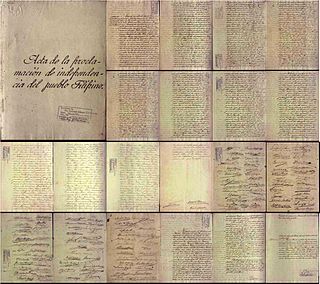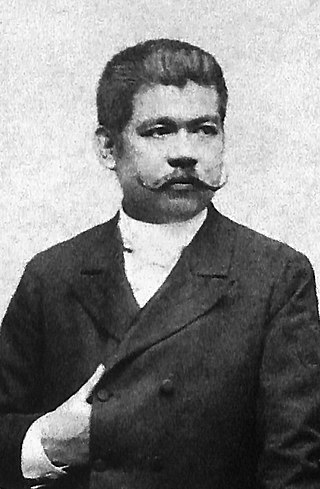| |||||
| Decades: | |||||
|---|---|---|---|---|---|
| See also: | |||||
1895 in the Philippines details events of note that happened in the Philippines in the year 1895.
| |||||
| Decades: | |||||
|---|---|---|---|---|---|
| See also: | |||||
1895 in the Philippines details events of note that happened in the Philippines in the year 1895.

As a colony of Spanish Empire and being a catholic colony, the following were considered holidays:

Emilio Aguinaldo y Famy was a Filipino revolutionary, statesman, and military leader who is the youngest president of the Philippines (1899–1901) and became the first president of the Philippines and of an Asian constitutional republic. He led the Philippine forces first against Spain in the Philippine Revolution (1896–1898), then in the Spanish–American War (1898), and finally against the United States during the Philippine–American War (1899–1901).

The Commonwealth of the Philippines was the administrative body that governed the Philippines from 1935 to 1946, aside from a period of exile in the Second World War from 1942 to 1945 when Japan occupied the country. It was established following the Tydings–McDuffie Act to replace the Insular Government, a United States territorial government. The Commonwealth was designed as a transitional administration in preparation for the country's full achievement of independence. Its foreign affairs remained managed by the United States.

Melchora Aquino de Ramos was a Filipino revolutionary. She became known as "Tandang Sora" because of her age during the Philippine Revolution.

Spanish was the official language of the Philippines from the beginning of Spanish rule in the late 16th century, through the Philippine–American War (1899-1902) and subsequent United States colonization and remained co-official after independence in 1946, along with Filipino and English, until 1973. Its status was initially removed in 1973 by a constitutional change, but after a few months it was re-designated an official language again by a presidential decree. With the present Constitution, Spanish became designated as an auxiliary or "optional and voluntary language".

The Philippine Revolution, also called the Tagalog War, was a conflict waged by the Filipino revolutionaries against the Spanish colonial authorities in an attempt to win the country's independence.

Filipino nationalism refers to the establishment and support of a political identity associated with the modern nation-state of the Philippines, leading to a wide-ranging campaign for political, social, and economic freedom in the Philippines. This gradually emerged from various political and armed movements throughout most of the Spanish East Indies—but which has long been fragmented and inconsistent with contemporary definitions of such nationalism—as a consequence of more than three centuries of Spanish rule. These movements are characterized by the upsurge of anti-colonialist sentiments and ideals which peaked in the late 19th century led mostly by the ilustrado or landed, educated elites, whether peninsulares, insulares, or native (Indio). This served as the backbone of the first nationalist revolution in Asia, the Philippine Revolution of 1896. The modern concept would later be fully actualized upon the inception of a Philippine state with its contemporary borders after being granted independence by the United States by the 1946 Treaty of Manila.

The Ayala Museum is a museum in Makati, Metro Manila, Philippines. It is run privately by the Ayala Foundation and houses archaeological, ethnographic, historical, fine arts, numismatics, and ecclesiastical exhibits. Since its establishment in 1967, the museum has been committed to showcasing overseas collections and situating contemporary Philippine art in the global arena in a two-way highway of mutual cooperation and exchange with local and international associates. The museum was reopened on December 4, 2021, after a two-year renovation.

Epifanio de los Santos y Cristóbal, sometimes known as Don Pañong or Don Panyong, was a noted Filipino historian, journalist, and civil servant. He was regarded as one of the best Filipino writers and a literary genius. He also entered politics, serving as a member of the Malolos Congress from 1898 to 1899 from Nueva Ecija and later as governor of Nueva Ecija from 1902 to 1906. As a lawyer, he was named as the district attorney of San Isidro, Nueva Ecija in 1900 and later as fiscal of the provinces of Bulacan and Bataan. He was named as an assistant technical director of the Philippine Census in 1918. He was appointed Director of the Philippine Library and Museum by Governor General Leonard Wood in 1925, serving until his death in 1928.

The Philippine Republic, now officially known as the First Philippine Republic, also referred to by historians as the Malolos Republic, was established in Malolos, Bulacan during the Philippine Revolution against the Spanish Empire (1896–1898) and the Spanish–American War between Spain and the United States (1898) through the promulgation of the Malolos Constitution on January 22, 1899, succeeding the Revolutionary Government of the Philippines. It was formally established with Emilio Aguinaldo as president. It maintained governance until April 1, 1901.

The history of the Philippines from 1898 to 1946 began with the outbreak of the Spanish–American War in April 1898, when the Philippines was still a colony of the Spanish East Indies, and concluded when the United States formally recognized the independence of the Republic of the Philippines on July 4, 1946.

Don Felipe Agoncillo y Encarnación was the Filipino lawyer representative to the negotiations in Paris that led to the Treaty of Paris (1898), ending the Spanish–American War and achieving him the title of "outstanding first Filipino diplomat."

The history of the Philippines from 1565 to 1898, also called the Spanish Era, is the period during which the Philippine Islands were ruled as the Captaincy General of the Philippines within the Spanish East Indies, initially under the Kingdom of the Viceroyalty of New Spain, based in Mexico City, until the independence of Mexico from Spain in 1821. This resulted in direct Spanish control during a period of governmental instability there. The Philippines was under direct royal governance from 1821 to 1898.

Camilo García de Polavieja y del Castillo-Negrete, 1st Marquess of Polavieja was a Spanish general born in Madrid on July 13, 1838, in a family of merchants. He was an able commander, but considered as brutal as Valeriano Weyler of Cuba.

Marcelo Hilario del Pilar y Gatmaitán, commonly known as Marcelo H. del Pilar and also known by his pen name Pláridel, was a Filipino writer, lawyer, journalist, and freemason. Del Pilar, along with José Rizal and Graciano López Jaena, became known as the leaders of the Reform Movement in Spain.

José Protasio Rizal Mercado y Alonso Realonda was a Filipino nationalist, writer and polymath active at the end of the Spanish colonial period of the Philippines. He is considered the national hero of the Philippines. An ophthalmologist by profession, Rizal became a writer and a key member of the Filipino Propaganda Movement, which advocated political reforms for the colony under Spain.
1896 in the Philippines details events of note that happened in the Philippines in the year 1896.

The Unión de Impresores de Filipinas was one of the first national trade union centers in the Philippines, along with the Unión Obrera Democrática Filipina. Established in 1906, it was a national union of all workers in the printing trade intended to consolidate them into a single confederation.